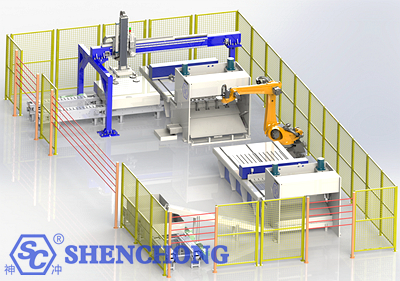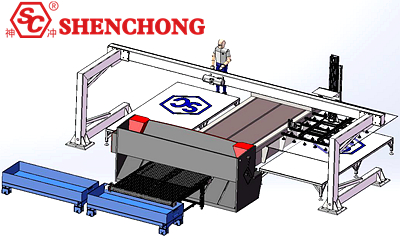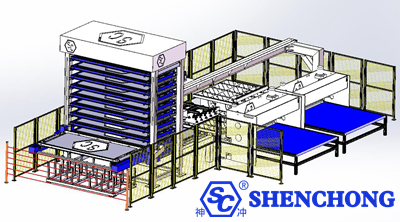
According to market research, 99% of sheet metal processing companies in the sheet metal and manufacturing industry are currently facing many problems, such as large equipment footprint, large number of operators, continuously increasing labor costs, a lot of time wasted in the product logistics operation link, disorderly placement, seemingly high efficiency of single equipment but actually very low delivery efficiency, a wide variety of parts, abnormally slow material flow, and chaotic on-site operations, which seriously restrict the development of automated production loading and unloading in the sheet metal and manufacturing industry.

The flexible production equipment of sheet metal cutting workshop includes shelves, pallets, in-and-out elevators, raw material out-and-out trolleys, laser loading and unloading equipment, semi-finished product trolleys, and the installation, electrical debugging, software debugging of the entire automatic production system, and sheet metal three-dimensional material warehouse.
- Raw materials are stored in a three-dimensional material warehouse, which is convenient for management and saves factory space.
- Adopting an intelligent management system, the inventory of plates can be quickly grasped in real time, raw materials can be automatically retrieved, and raw materials can be switched quickly, which can meet the frequent switching needs of multi-batch and small-variety production.
- One-button start, automatic operation.
- Large-capacity storage space, safe and fast operation.
- Automatic loading and unloading, which can realize continuous production.
- Suction cup loading and tooth unloading can prevent the plates from being scratched on the sawtooth cutting table.
- With plate measurement function, it can actually display the thickness of the current plate being loaded, and can intercept raw materials that do not meet the product thickness.
- With the function of double-layer process separation of plates, it can ensure the loading of single.
- Improve work safety, reduce the risk of injury, and reduce the work intensity of staff.
- Professional team design is suitable for most factory workshops.
- Customer satisfaction with the automated production site is improved.
- The on-site 5S management is neat and orderly, and the overall site is convenient for customers to visit.
The loading and unloading analysis of sheet metal flexible automated production lines includes the automated input and output process of materials, which is a key link in the entire production process and directly affects production efficiency, cost control and quality stability. The analysis of loading and unloading involves multiple aspects such as equipment, automation technology, layout optimization and flexible operation.
The following is a detailed analysis:
Loading refers to the process of transferring sheet metal raw materials (usually plates) from warehouses or storage areas to processing equipment. The automation of loading helps reduce manual intervention and improve efficiency and safety.
In sheet metal flexible production lines, robotic arms or automatic loaders are often used to grab, carry and position plates. These devices automatically transport plates to cutting or stamping equipment through pre-programmed actions.
To achieve flexible production, automated production lines can be equipped with multiple bins that can store and automatically switch plates of different types or sizes to meet the needs of different workpieces. This helps reduce downtime and manual intervention.
By integrating CNC systems and MES systems, production lines can achieve intelligent scheduling of loading. The system automatically selects materials according to order requirements, arranges the loading sequence, and ensures seamless loading process.
Unloading is the process of removing processed sheet metal parts from the equipment. Automated unloading can increase production speed and ensure safe operation.
Similar to loading, automatic unloading usually moves the processed parts from the cutting area to the designated location through a manipulator or conveying system. This process does not require human intervention, ensuring the continuity of production.
In order to ensure that the workpieces after unloading are clearly classified, the automation system can be equipped with intelligent identification and sorting functions. Through scanning, sensors or image recognition technology, the workpieces will be automatically classified and stacked in the designated area to reduce the risk of confusion and misplacement.
The automatic unloading system is usually equipped with a waste handling device to automatically transport the scraps or waste generated after cutting to the recycling area for subsequent processing. This not only improves the cleanliness of the factory, but also optimizes waste management.
The loading and unloading equipment of the sheet metal flexible automated production line can flexibly adapt to the production needs of multiple varieties and small batches. The loading equipment can quickly change the sheet according to the production plan to meet the manufacturing needs of different products.
The automated operation of loading and unloading not only reduces manual intervention, but also makes the entire production process smoother. Especially in batch production, the flow speed of workpieces and materials is greatly improved.
By reducing manual operation and waiting time, the utilization rate of production lines is greatly improved. The automation of loading and unloading can keep the machine running continuously and reduce downtime.
Another key to loading and unloading is the optimization of layout, which is directly related to material utilization and production efficiency.
Layout optimization uses software (such as SigmaNEST, OptiNest) to intelligently arrange the cutting position of the workpiece according to the shape of the workpiece and the size of the sheet, maximize the use of materials, and reduce waste generation. This process is combined with the CNC system when loading to ensure that each sheet is maximized.
The intelligent equipment in the flexible production line can adjust the order and method of unloading in real time to ensure that multiple varieties of workpieces can be processed in the shortest time, and automatically sort and stack various workpieces.
Automated loading and unloading equipment significantly reduces the time of human intervention and improves overall production efficiency. Especially in mass production, the automatic loading and unloading system ensures the continuous and efficient operation of the equipment.
The automated production loading and unloading system in the flexible line requires highly accurate programming and equipment maintenance to ensure the smooth progress of all links. The initial investment cost of the equipment is high, and the skills required of the operator are high, especially when setting up and writing programs.
Through the data integration of the loading and unloading links, the system can monitor data such as raw material consumption, production progress, and equipment status. This data-driven management model not only improves production efficiency, but also optimizes the loading and unloading process based on real-time feedback.
In summary, the automated production loading and unloading covers the entire process from automatic loading of sheets to unloading of finished products and waste. Through automated equipment and intelligent control systems, the production line can achieve efficient, flexible and precise loading and unloading operations, greatly improving overall production efficiency and optimizing material utilization.

Flexible production in sheet metal cutting workshops can achieve fully automatic operation of automated production lines through communication between the central control system and the laser cutting machine.
The process includes: automatic switching of plates → automatic loading → automatic processing → automatic unloading. The operation process automatically cycles without manual intervention.
Flexible production can free people from tedious, disorderly, and low-end work to engage in core affairs, greatly reducing the degree of dependence on personnel, making work more technical and challenging, so that staff members love their work more.
At present, the material preparation workshop is manually picking up materials → manually issuing materials → manually loading materials → manually unloading materials from raw materials to cutting completion.
The entire process is mainly realized by people. Due to the complex product types and frequent plan adjustments, it is completely feasible to use automatic material storage + automatic loading and unloading to achieve flexible production in the cutting workshop.
In the material preparation workshop, from the storage of raw materials to the completion of cutting and unloading, each laser cutting equipment is equipped with 2 people per shift, and 5 equipments are operated in 3 shifts, with a total of 30 people.
If the stereoscopic warehouse + automatic loading and unloading is realized, the workshop material manager and material dispatcher can save at least 4 people, and each equipment can save 1 person per shift.
If all equipments are operated in 3 shifts, theoretically 19 people can be saved. At present, because some equipments are not operated in 3 shifts, at least 10 people's salary costs can be saved according to this calculation, and other indirect costs have not been calculated. The direct labor cost saving is about more than 900,000 yuan per year.
Automatic material warehouses can only make one size and can only solve about 70% of the material automation management needs. The other 30% still need to be handled manually, and the side material management still needs to be managed by manual real-time entry into the ledger.
To achieve automation, lean management + automation equipment + information management software are necessary conditions, among which the foundation of lean management must be well done, which is the basic condition for achieving automation.
The acceptance of automation and the level of cognition of information management systems by workshop personnel vary, and they have no relevant experience. If a certain link is stuck, the entire line will be unable to operate. This risk will be relatively large and there is no systematic and scientific safeguard.
The one-time investment is large, and small and medium-sized enterprises have limited funds. They are worried that the return time after the one-time investment will be long, and the investment and return are not proportional.

Using automatic material storage + automatic loading and unloading to achieve flexible production in sheet metal cutting workshops, increasing the one-time investment according to the above plan, and calculating according to saving labor costs and improving work efficiency, it is estimated that the cost can be recovered in 2 to 3 years.
Using automated production loading and unloading lines, the efficiency is certain every day and every hour, without human factors. If the loading and unloading production line is not used and manual loading and unloading is still used, the inertia of people cannot be controlled and the efficiency is uncertain.
Assuming that the manual loading time is t1=1.5 minutes/sheet, the cutting time is t2=3 minutes/sheet, and the cutting machine exchange table time is t3=0.5 minutes/sheet, and the production line has pre-loading, the automated loading and unloading time can be ignored, the specific efficiency improvement data is as follows:
Manual loading count: n1=60/(t1+t2+t3)=60/(1.5+3+0.5)=12 sheets
Production line loading count: n2=60/(t2+t3)=60/(3+0.5)≈17.14 sheets
Increased efficiency p=(n2-n1)/n1×100%=(17.14-12)/12×100%≈43%
The automated production line loading and unloading is adopted, and the labor intensity of workers is reduced; the entire production line is surrounded by safety guardrails, safety is also guaranteed accordingly, and the appearance image is also greatly improved.
In general, realizing flexible production in sheet metal cutting workshops will improve the company's overall management level, reduce the number of operators and managers, and reduce warehouse area.
On the other hand, according to the company's management level and product structure, some functions still require manual assistance, and the one-time investment cost is relatively high. At the same time, there is a lack of management of sheet metal edge materials in domestic three-dimensional material warehouses.